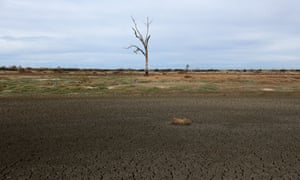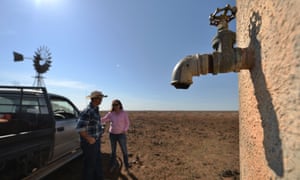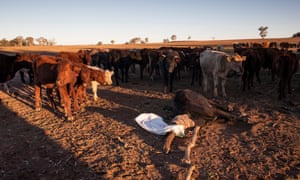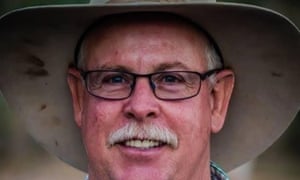
Out in the Macquarie Marshes, about 1ookm north of Warren in the
central west of New South Wales, large inland wetlands have become a
place for the dead and dying.
“We went out last night and there was a little patch of water with dead and dying European carp,” Richard Kingsford, the director of the Centre for Ecosystem Science at the University of NSW, says. “There’s dead and dying things everywhere. Kangaroos dying and even foxes are dying.
“We were trying to trap for turtles but there doesn’t seem to be enough water for turtles. I’m not sure where they’ve gone to.”
There are large parts of the Macquarie River that have dried up completely as the state remains in the grip of one of the most severe droughts on record.
Valley water storages in the Macquarie are sitting at 11%. In the Namoi, in north-west NSW where water shortages have been acute, they’re at 1.5%. The Border Rivers, in the region between the NSW and Queensland border, are at 6%. In Sydney, dam storages have dropped below 50% for the first time in more than a decade.

“We went out last night and there was a little patch of water with dead and dying European carp,” Richard Kingsford, the director of the Centre for Ecosystem Science at the University of NSW, says. “There’s dead and dying things everywhere. Kangaroos dying and even foxes are dying.
“We were trying to trap for turtles but there doesn’t seem to be enough water for turtles. I’m not sure where they’ve gone to.”
There are large parts of the Macquarie River that have dried up completely as the state remains in the grip of one of the most severe droughts on record.
Valley water storages in the Macquarie are sitting at 11%. In the Namoi, in north-west NSW where water shortages have been acute, they’re at 1.5%. The Border Rivers, in the region between the NSW and Queensland border, are at 6%. In Sydney, dam storages have dropped below 50% for the first time in more than a decade.

Repeat episode?
But early outlooks for spring and December are again pointing to above average temperatures. And with the exception of parts of Western Australia and the west of Tasmania, the outlook is for below average rainfall.“For most of Australia it’s this consistent dry story for the remainder of the year,” Jonathan Pollock, a climatologist at the Bureau of Meteorology, says. “It’s very likely it’s going to be hotter than usual and it’s very likely it’s going to be drier than usual.”
For the first eight months of the year, the country’s mean temperature was the second warmest on record. Mean maximums were the warmest on record over the same period and mean minimums the equal-sixth warmest.
Rainfall through winter was below to very much below average for most of the country, including New South Wales, southern and western Queensland, parts of northern and eastern Victoria, the east coast of Tasmania, the majority of South Australia and the Northern Territory, and most of the eastern half of Western Australia, and some coastal areas in the west of that state.

Pollock says it would take something like a La Niña, which is associated with heavier rainfall, “to bring the turnaround that we need”.
The El Niño-Southern Oscillation is currently neutral and is expected to remain so until the end of 2019 and into early 2020.
The prolonged dry and warm conditions have meant authorities have already issued warnings for the spring and into summer.
Fire services have told communities to be ready for a challenging bushfire season and to prepare their homes, properties and evacuation plans early.
"In drought-hit parts of eastern and southern Australia, rainfall levels for the season were in the lowest 10% of historical records."
The Bushfire and Natural Hazards Cooperative Research Centre published its seasonal outlook last week, which warned parts of Queensland, New South Wales, Victoria, Tasmania, and parts of Western Australia and South Australia, face an above normal potential fire threat.
On Friday, just a week into September, authorities issued total fire bans in Queensland and parts of New South Wales, with extreme, and potentially catastrophic, conditions expected in some areas.
Richard Thornton, the chief executive of the Bushfire and Natural Hazards Cooperative Research Centre, said winter had brought some significant fires to the north of the country and recent weeks had seen a spate of fires in south-east Queensland and NSW.
He said the ongoing drought was driving much of the risk this season and there was concern for forested areas that were already dry heading into the warmer months.
Thornton said that included a swathe beginning south of Rockhampton in Queensland and running all the way down the east coast into NSW and east Gippsland in Victoria.
“That takes in the major populated areas in south-east Queensland and around Sydney and the ACT – so some pretty significant population centres,” he said.
He said the conditions in eastern Tasmania, South Australia’s Eyre Peninsula and Kangaroo Island, south-western WA and parts of the Nullarbor, where rainfall has regenerated grasslands, also looked challenging.

In the summer of 2018, low river flows caused by a combination of drought and over-extraction of water, coupled with extreme temperatures, caused an environmental catastrophe that killed thousands of fish.
Fisheries managers say they anticipate more fish are likely to perish this season if the drought continues.
A spokeswoman for the NSW Department of Primary Industries said it was “an evolving situation” and aquatic habitats were being closely monitored.
“Significant concerns are held for the Lower Darling, Namoi, Macquarie and Lachlan catchments in the early part of the summer as well as the Barwon-Darling, Border Rivers and Gwydir should current conditions persist,” she said.
Up in Queensland, Angus Emmott, an ecologist and farmer, runs a cattle station about 130km south-east of Longreach.

The property primarily receives its rain in summer but, until last year, it had what he calls “eight failed summer rains in a row”.
That broke last summer, as a result of “two big floods”.
“We’re having a really good season unlike much of the country to the east of us,” Emmott says. “Up above us, near Julia Creek, they’ve had so much rain it killed three-quarters of a million head of cattle and washed all the fences and pastures away when Townsville got flooded as well”.
Emmott says for his farm it was a case of “luck”. The rains that had helped his property last year had caused catastrophe further north. And outside of the floodplains, places were still in drought.
“One thing that’s really affected agriculture in this part of the country is climate change,” he says. “That brings hotter than normal temperatures, drier than usual weather and higher minimums.
“Then what is happening is when we get a rainfall event there’s more of a chance of them being massive, like the one at Julia Creek, which created havoc.”
Emmott is on the board of the advocacy group Farmers for Climate Action. In a bit more than a week, he says farmers will be travelling to Canberra to call for a national strategy on climate and agriculture.
“I think things can change and they actually are but they would change so much quicker if we had a government that took some leadership,” he says. “If we didn’t have to drag them kicking and screaming, we’d get places a lot quicker. This applies to both sides of politics. They talk the talk and then do nothing.”
No comments:
Post a Comment